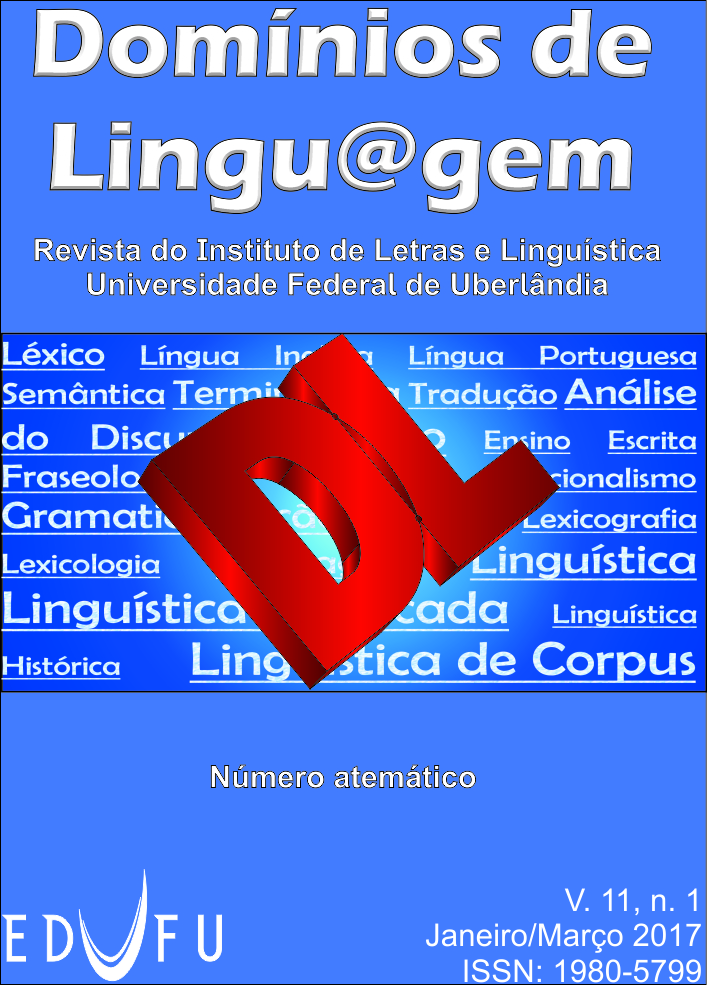Evidences of washback effect in the teaching of Portuguese Language from the New National Secondary Education Examination
DOI:
https://doi.org/10.14393/DL28-v11n1a2017-11Keywords:
Washback Effect, New ENEM, Portuguese LanguageAbstract
This paper presents results of a master's research that investigated whether the New National Secondary Education Examination has generated washback effect in Portuguese high school language classes. It is theoretically based both on Chapelle (1999) and Scaramucci (2011) on what regards the concept of validity, and on Alderson and Wall (1992) and Scaramucci (2004) regarding the conceptualization of Retroactive Effect. Interpretative analysis of the instruments was carried out in the light of Content Analysis methodology by Bardin (2010). The results show a negative retroactive effect in schools. The common sense that private schools adapt faster and even more efficiently to change has not been scientifically proven.Downloads
Metrics
References
ALDERSON, J. C.; WALL, D. Does washback exist? Working Paper Series 11. CRILE, Lancaster University Republicado em Applied Linguistics 14, p. 115-129, 1993.
BAKHTIN, M. Estética da criação verbal. 2. ed. São Paulo: Martins Fontes, 1997.
BARDIN, L. Análise de Conteúdo. Lisboa: Edições 70, 2010 Linguistics, 19. p. 254-272.
BRONCKART, J. P. Atividade de linguagem, textos e discursos: por um interacionismo sociodiscursivo. São Paulo: EDUC, 2003.
BURROWS, C. Washback in classroom-based assessment: a study of the washback effect in the Australian adult migrant English program. In: Em Cheng, L., Watanabe, Y; Curtis, A. Washback in Language Testing – Research Contexts and Methods. Lawrence Erlbaum Associates, New Jersey, 2004. p. 113-128.
CHAPELLE, C. A. Validity in language assessment. Annual Review of Applied, 1999.
FAZENDA, I. C. A. (Org.) Didática e interdisciplinaridade. Campinas: Papirus, 1998.
GOMES, L. L. Z; FELICE, M. I. V. Um estudo a partir das questões de língua portuguesa de provas do novo Enem. Revista L@el em (dis-)curso, v. 6, n. 2, 2014.
HUGHES, A. Testing for language teachers. Cambridge: Cambridge University Press, 1989.
INEP. Matriz de Referência para o ENEM 2009. Brasília, s/d. Disponível em: <http://www.enem.inep.gov.br> Acesso em: 27 set. 09.
LI, Y. A preparação de candidatos chineses para o exame CELPE-Bras: aprendendo o que significa "uso da linguagem". Dissertação de mestrado. Programa de Pós Graduação em Letras, IL, UFRGS.
MCNAMARA, T. Language Testing. Oxford: Oxford University Press, 2000.
PEÑA, M. D. J. Interdisciplinaridade: questão de atitude. In: FAZENDA, I. (Org.) Práticas interdisciplinares na escola. São Paulo, Cortez, 2005. pp.57-64
PESSÔA, A. R. O efeito retroativo de um exame de seleção no ensino de inglês. Trabalhos em Lingüística Aplicada, Campinas, v. 43, n. 2, p. 287-305, Jul./Dez. 2004.
PIRES, M. F. C. Multidisciplinaridade, interdisciplinaridade e transdisciplinaridade no ensino. Interface (Botucatu) [online]. 1998, v. 2, n. 2, p. 173-182. https://doi.org/10.1590/S1414-32831998000100010
RETORTA, M. S. Efeito retroativo do vestibular da Universidade Federal do Paraná no ensino de língua inglesa em nível médio no Paraná: uma investigação em escolas públicas, particulares e cursos pré-vestibulares. Sínteses, vol. 13. Unicamp: 2008. Disponível em <http://www.iel.unicamp.br/revista/index.php/sinteses/article/ viewFile/835/586>. Acesso em 30 set 2010.
SCARAMUCCI, M. V. R. Vestibular e ensino de língua estrangeira (Inglês) na escola pública. Trabalhos em Lingüística Aplicada, 34, p. 7-20, Departamento de Lingüística Aplicada, Unicamp. 1999.
______. Efeito retroativo da avaliação no ensino/aprendizagem de línguas: o estado da arte. Trabalhos em Lingüística Aplicada, v. 43, n. 2, 2004. p. 203-226. https://doi.org/10.1590/S0103-18132004000200002
______. Validade e conseqüências sociais das avaliações em contextos de ensino de línguas. Arena. Vol. 2. Ano 2011. p. 103-120
Downloads
Published
How to Cite
Issue
Section
License
Authors who publish in this journal agree to the following terms:
Authors retain the copyright and waiver the journal the right of first publication, with the work simultaneously licensed under the Creative Commons Attribution License (CC BY-NC-ND 4.0), allowing the sharing of work with authorship recognition and preventing its commercial use.
Authors are authorized to take additional contracts separately, for non-exclusive distribution of the version of the work published in this journal (publish in institutional repository or as a book chapter), with acknowledgment of authorship and initial publication in this journal.









